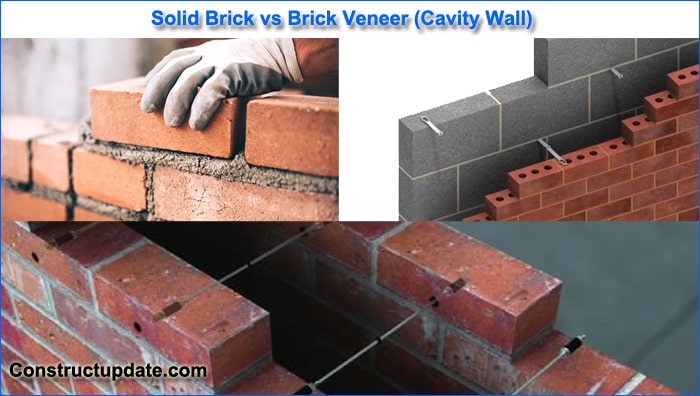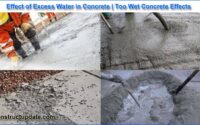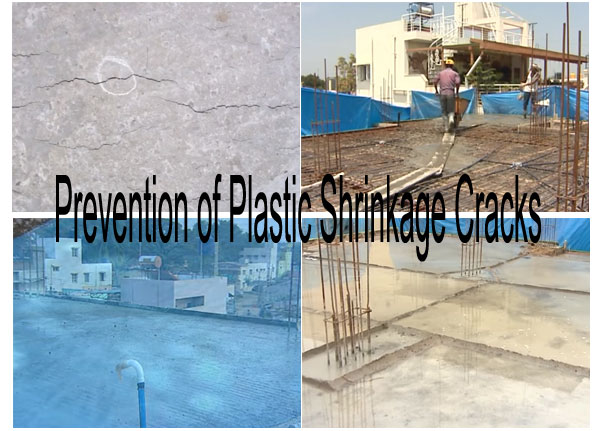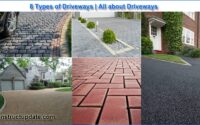Solid Bricks Vs Brick Veneer or Cavity Wall, Differences between Solid Masonry and Brick Veneer
Solid Brick / Solid Masonry
Up to the mid-1900s, solid masonry, or traditional brick building, was extremely popular. This style of construction is often referred to as “double brick,” “solid brick,” or “brick and block.” In this kind of masonry building, header bricks are used to hold together multiple layers of brick (referred to as “wythes”). Before 1900, some solid stone walls were nearly 20″ thick! The inner wythe was frequently replaced with concrete or cinder block because it cannot be seen from the outside. Solid brick walls occasionally had metal connections. The majority of those original ties have unfortunately rusted away because older solid walls with these connections did not use hot-dip or stainless steel ties.
Building with sturdy masonry was unquestionably a sound choice. They were 8 inch or bigger wall thickness.
Capable of supporting a broad range of various roof structures. Carpenters frequently collaborated to construct the floor joists into the walls while the brickwork was being installed.

Brick Veneer (Cavity Wall)
The primary structural support is where brick veneer and solid brick differ the most. The building’s structural support is made of solid masonry. With brick veneer, the concrete, steel, or wood that make up the backup wall provide the structural support, and the brick is just there on the exterior for cosmetic reasons. In contrast to a solid masonry building, which would have multiple wythes, the brick veneer is only one wythe thick. Between the brick and the backing wall, there is an exposed space that can be filled with insulation and mortar collection materials.
Brick veneer walls need to be properly flashed and equipped with weep holes so that water can drain from the cavity and onto the building’s outside. The usage of cavity walls was revived in Great Britain in the late 1800s but did not really take off until the mid-1900s. Cavity walls can be found in older structures.
i) Costs
Solid Brick
Brick veneer is less expensive than actual brick when it comes to constructing materials.
Brick Veneer
However, brick veneer is far less expensive than solid brick, making it a better choice for individuals on a tight budget.
ii) Energy Efficiency
Solid Brick
Due to its innate thermal properties, solid brick is not energy efficient.
Brick Veneer
The space between the outside veneer and the backing wall, which separates the insulation material, makes brick veneer more energy efficient.
iii) Header Brick
Solid Brick
The majority of solid masonry construction uses header bricks, which are recognised as a row of shorter bricks on the facing of the wall.
Brick Veneer
For brick veneers, on the other hand, there are no header brick designs.
iv) Installation
Solid Brick
Since solid brick is essential to a home’s structural soundness, it should be laid while the house is being built.
Brick Veneer
On the other hand, brick veneer can be fastened wherever. Because just one wythe is required to achieve the appearance and texture of actual brick, the installation process will go considerably more quickly.
v) Water Drainage
Both types of brick masonry rely on the link between the mortar and masonry units to prevent water perforation because brick is not a waterproof material.
Solid Brick
This particular style of brick masonry depends on its substantial mass to absorb outside water.
Brick Veneer
This kind of brick masonry will be vulnerable to water damage if it is not installed correctly.
vi) Insulation
Solid Brick
If you want the best insulation for your home, solid brick is not the ideal choice. This is so because the material does not encourage airflow by being light and soft.
Brick Veneer
Since insulation may be added in the gap between the brick and the outer walls when the brick veneer is built, brick veneer is a preferable alternative for insulation.
vii) Structural
Solid Brick
As they are structural, solid brick walls are typically erected when a building is being built.
Brick Veneer
Because they are only affixed to the structural backup walls, brick veneer walls are not structural.
viii) Benefits
Solid Brick
Life Span: Brick that is solid resilient and fireproof. Additionally, it can withstand disasters like strong winds and earthquakes.
Resilience: Since this style of the building does not require wood, termites and decay are not a concern.
Low-Maintenance Benefits: Solid brick requires less upkeep because it is durable and retains its colour well.
Brick Veneer
Installation: Because it may be added at any time, including after the building of your home is complete, it is simpler to install.
Price: Brick veneer is three times more affordable than brick itself.
Your personal tastes and financial constraints will influence your decision between solid brick and brick veneer.
Both have advantages and disadvantages, so you must carefully consider your options because your decision will have an impact on the overall construction and durability of your home. Your house will act as your roof and fortress against the elements.
Make careful to choose the best brick veneer provider for your project when you decide to use brick veneer.
Select a contractor who has handled numerous successful projects and has industry experience. No matter which of the two you select, always take the construction of your home into account.





